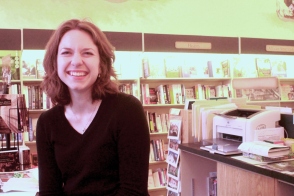Summer tastes like cut grass and infield dirt and warm water out of paper Dixie cups. Between the ages of ten and sixteen I spent every summer banging dirt out of my cleats on the dugout cement, dreaming about the boys in the big league.
First Base
I was fourteen and pretty sure I’d be the first girl in the history of ever to get a high school diploma before she got kissed. And then I got kissed and it was so sadly cliched I wanted a do-over even at the time. We were on the band bus on the way home from a football away game when I was fed a sluggish mouthful of tongue. I would not kiss anyone else until I was in college.
First base was my favorite base in softball, though I never fielded it, being neither tall nor left-handed. But as a runner you can run past it and still be safe. On the other bases an infielder could tag you out with the ball if you overran the base, but you can stomp on first and blow on past at top speed into the outfield. You could could just keep going, really, out past the fence and the wild grass into the corn and down to the river or beyond.
Second Base
In girl’s softball, you aren’t allowed to lead off the bases; you have to wait until the ball leaves the pitcher’s hand before teasing to the right. On base at second I was invisible to the pitcher and felt sly as though holding up bunny ears behind her in a snapshot. I was slow, so the possibility of getting past the shortstop and third baseman to steal was slim, but still, I liked that I represented a threat.
The boys in high school thought I was a tease, but I was really just terrified. How long do you play defense against them? I liked that I represented a challenge, but not the prize. I was more comfortable shifting from one crouched leg to the other along the baseline between first and second, swaying slightly, letting my glove trace the sign of infinity in the infield dirt between my cleats.
Third Base
In eleventh grade Jackie Parson turned to me in English class and said, “Did you know a blow job has absolutely nothing to do with blowing?” I answered something like, “Oh yeah! That’s so weird!” even though I didn’t really have clue.
It is the most physical of bases, always sliding into it if you’re doing it right. Hit a triple, steal, get caught looking at home a little too hungrily and take two lurching steps back before sliding in safe. The third baseman, shortstop, pitcher, and catcher all keep a wary eye on it: the penultimate step before changing the whole game.
Fourth Base
In college I slunk away from a bonfire when they started passing the bottle of Jack Daniels and playing “never have I ever.” The girls giggled and acted coy, as though they actually had done the acts they pretended they hadn’t, saying they’d never “done it” in a lifeguard chair or their parent’s minivan. I just never had. Ever. I was very far away from home.
Fourth base represented my target, the goal I studied in class behind my eyelids. I was a pitcher. I threw windmill — the style of whirling your arm in one fierce circle while taking a saucy, hip-swinging step towards home base. I pictured a channel of energy stretching from my open hand, beneath the hitter’s bat, smack into the catcher’s glove. I was in charge. I got what I wanted. What secret did I know? There is no fourth base; only home.
© Llalan Fowler, 2013
_________________________________________________________________________

Hello. My name is Llalan, pronounced LAY-lin. I am a reader, a writer, and an Ohioan. I am also the manager of Main Street Books, the only independent, general bookstore in Mansfield, Ohio. So not only am I a big reader, but I am also an avid supporter of local business. Please visit my blog, The Bookstore Lady, which follows the ups and downs of bookselling in a small town, the trials and successes of running a small business and some difficult or beautiful parts of just being human.
Other incidentals that might be helpful to know: I love beer, am kind of a snob about it, and have been known to brew it when the mood suits (I actually write for another blog called PitchKnives & ButterForks in a column called “Just Add Beer”); sometimes I cry at commercials, even the ones just about paper towels; I have never been tan in my life.


